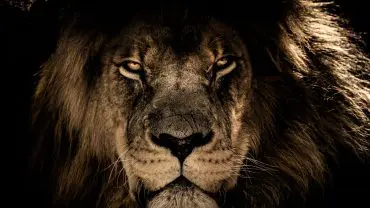The Bengal tiger is one of the world’s most awe-inspiring creatures. They are immensely powerful and command a presence like few members of the animal kingdom can.
Here is everything you need to know about these magnificent animals including the best facts about Bengal tigers.
How big are Bengal Tigers and how long do they live?

A Bengal tiger on the run (Photo: slowmotiongli via iStock)
Bengal tigers are one the largest tiger species, second only to the Siberian tiger. Males are between 2.7 metres and 3.1 metres long and can weigh up to 275kg. Females are a little smaller, measuring around 2.4 metres long, weighing up to around 175kg.
There are stories of exceptionally large Bengal tigers including two tigers shot in India in the late 1800s measuring over 3.6 metres and another male killed in the Himalayan foothills in 1967 weighing almost 390kg. However, these aren’t verified Bengal tiger facts because there’s no documented evidence supporting the claims, so the tales are either apocryphal or possibly just exaggerations.
Like most tigers, Bengals can survive in the wild for anywhere between ten and fifteen years. In captivity, with proper care and attention, a controlled diet and a stress-free life – including not having to worry about other predators or competition – they can live up to twenty years.
Where do Bengal Tigers live?

A Bengal tiger in its habitat (Photo: Prasanna S via iStock)
Bengal tigers are very adaptable and live in tropical, subtropical and temperate rainforests, as well as grasslands, wetlands and mangroves. They are incredibly hardy and can cope with both hot and cold conditions.
The distribution facts about Bengal tigers outline that India is home to around 70% of all wild Bengal tigers. Today, there are around 3,000 Bengal tigers in India, between 300 and 500 in Bangladesh, roughly 250 in Nepal and a little over 100 in Bhutan.
What do Bengal Tigers eat?

A Bengal Tiger having a feast (Photo: Shams via iStock)
Indian tigers, as Bengals are often known, have the longest canine teeth of any cat and can reach up to 10cm in length – that’s around half the size of the world’s smallest shark!
They are ‘stalk and ambush’ hunters, quietly stalking their prey and then pouncing, usually from behind. Their diet consists largely of deer, bison, water buffalo, wild pig and antelope. However, on occasion, Bengals will eat leopards, foxes, crocodiles and even bears. One of the strangest Bengal tiger facts is that one specimen shot by hunters was found with a stomach full of venomous king and Indian cobra snakes!
On average, only one in ten Bengal Tiger hunts is a success, so they will usually only eat one big meal a week, and they really do know how to gorge. They can eat up to 40kg of meat in one sitting!
Bengal Tiger Facts

A Bengal tiger surveys his territory (Photo: Cheryl Ramalho via iStock)
A National Animal, Literally…
The Bengal tiger is the national animal of both India and Bangladesh. The East Bengal regiment of the Bangladesh Army is nicknamed the Bengal Tigers and the logo of the Bangladesh Cricket Board features a Bengal tiger. The Bengal tiger even appears on Bangladeshi banknotes and has appeared on Indian coins.
Please Wear a Mask…
…But not for the reasons you think. One of the strangest Bengal tiger facts is that residents of jungle villages that share space with wild Bengals have taken to wearing masks of faces on the back of their heads. Tigers prefer to attack from behind so if the animal thinks the person is looking at them, they will – more often than not – search for another target.
The Champawat Tiger
The Champawat tiger was a female Bengal tiger that killed at least 436 people in Nepal and India between around 1895 and 1907. She was hunted for years before being shot by a game hunter. An autopsy revealed that the tiger’s teeth were broken and she couldn’t hunt her natural prey, so instead resorted to attacking humans for food to stay alive.
Bengal Tigers have Been In India a Long Time
Scientists believe that Bengal tigers have been in India for roughly 15,000 years, since the Late Pleistocene period.
Low Light? No Problem…
One of the most fascinating evolutionary facts about Bengal tigers is that they have white spots of fur on the back of each ear so that when they are out teaching their young the art of the hunt in the low dusk and dawn light, they are easy to follow.












